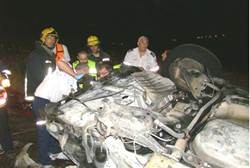Being aware of driving emergencies
A horrifying car crash a few weeks ago on the road from Tzfat to Tiberias in Israel killed eight members of the Atias family, leaving only one child alive. Although no one individual can possibly come to grips with the tragedy, questions of mechanical failure and safety were posed to a professor who researches highway safety and accidents at Ben-Gurion University’s Department of Industrial Engineering and Management, and to the American Automobile Association (AAA) to try to learn what might be done to survive a similar incident.
The car had passed inspection three months prior but the brakes failed on the steep hills to Tiberias. The driver, the father, was on the phone with the police as he repeatedly crashed into guardrails that ultimately failed to hold the out of control car. The car reportedly crossed the divider, flew about seven meters in the air, overturned, crashed and burst into flames. The dead included Rafael, 42, Yehudit, 42, Avia, 17, twins Eliyashiv and Neria Shimon, 16, Shira, 11, Tair, 8, and Noa, 4. Only Rachel Efrat, 7, survived. They were returning home from a dedication of a Torah and a new shul near Tzfat. The father was the principal of the Miftan School there.
A report on Israel National News quoted the former head of the Israel police accident investigation team, Jacob Netzer, that the causes of the brake failure are still being investigated. He suggested that it may be possible to slow a car with malfunctioning brakes by shifting down the gears or skidding along the safety barrier.
A week after the accident, other owners of the same type of vehicle, a Mitsubishi Grandis, complained of the gas peddle sticking and having to shift into neutral with one driver pulling up the gas pedal with her hand and another stepping on the brake to free the gas pedal.
As the summer approaches with families heading up to the mountains, children going to camp, and visiting day, this accident and another recent one on the Bronx River Parkway where seven died, brought attention to highway safety and measures drivers might be able to take to prevent such an event.
David Shinar, Ph.D., George Shrut Professor of Human Performance Management of the Department of Industrial Engineering and Management at Ben Gurion University of the Negev in Beer Sheva responded to email questions regarding the accident. “This was indeed a very dramatic and terribly violent crash,” he wrote. “All the information I have on it is from the press reports and from those I got the same impression. It was a brake failure due to totally worn out brakes - even though the car passed the safety inspection (including the brakes) three months before the crash. The area is very hilly and involves a lot of wear and tear on the brakes. The car went over the guardrail, which is really not expected to withstand such forces.
“Whether the driver could or could not have done something to prevent this is very speculative,” continued Shinar. “This was not the same problem as that experienced by Toyota where the gas pedal got stuck. If he had an automatic gear there was little he could have done except possibly to shift down to L. Also the emergency brake relies on the same brake pads so it would not have helped.
“So it is still a mystery how the car passed the inspection and how the driver was not aware of the bad brakes before - or why he disregarded that if he knew.
“It is a very sad story when a whole family perishes in a crash that was probably preventable.”
Robert Sinclair, Jr., Manager of Media Relations for AAA New York also responded via email. “Your message seems to point to different scenarios, one where brake failure occurred, another a stuck gas pedal and lastly a failed guardrail. All point to the need to be prepared for driving emergencies, regrettably something the vast majority of drivers have no training for.
“Brake failure is best handled by downshifting the transmission, automatic or manual, to help slow the vehicle, and using the emergency or parking brake. If higher speeds are involved, more extreme measures like running against a curb, guardrail or retaining wall would be needed. This would result in extreme damage to the vehicle, but it’s better than running into someone or something solid head-on.
“A stuck gas pedal is best dealt with by putting the vehicle in neutral and using the brakes to slow down. However, in light of the unintended acceleration debacle with Toyotas a couple years ago, most new cars are now built with braking systems that can overpower the engine, so for the owner of a newer vehicle, the advice is simply to step on the brakes, hard.
“Missing or inadequate guardrails are rampant on our roadways,” Sinclair continued, “witness the terrible crash on the Bronx River Parkway. The only way of dealing with them is to do all you can to avoid needing them by maintaining control of your vehicle, usually by keeping your speed down, being mindful of traffic around you and awareness of areas that lack proper guardrails.”
AAA New York offers safe driving courses that have as part of their curricula, advice on handling driving emergencies. More information is available on their website at www.ny.aaa.com.

 61.0°,
Mostly Cloudy
61.0°,
Mostly Cloudy 




